Artist Rene Magritte's Paintings
René Magritte was a well-known 20th-century surrealist painter from Belgium He is renowned for creating humorous paintings that are also lyrically enigmatic. Magritte is unique among the surrealists in that he takes ordinary materials derived from strange ratios and applies them instead of extraordinary ones. His paintings provoke thought and sometimes resemble riddles. However, these puzzles are intractable since they touch on fundamental issues about existence itself. René Magritte, who is regarded as one of the greatest surrealists of all time, referred to his style of painting as "magical realism." In the French-speaking part of Belgium, in 1898, René François Ghislain Magritte was born into a family of milliners and merchants. Due to his restless nature, Magritte's family frequently relocated cities. Afterwards, Magritte frequently alluded to his distaste for travel and the resulting changes. At fourteen years old, the adolescent experienced a traumatic event that profoundly affected his spirit: his depressed mother committed suicide by drowning in the River. In his biography, René Magritte discussed this terrible occurrence and expressed uncertainty regarding the veracity of his memory of seeing the mother's face covered by a white nightgown as she was being brought out of the water, as well as whether or not René Magritte had imagined this particular detail. Nonetheless, some of the artist's pieces depict situations that appear to be drowning ("Collective Invention") or show faces concealed by cloth ("Lovers," "The Invention of Life," "The Heart of the Matter"). The young guy relocated to Brussels in 1916 in order to enroll in the Royal Academy of Arts. Numerous institutions stopped during World War I, and the Academy took on a central role in student life. Magritte had a tight relationship with literary students, and he has always preferred to communicate with them. René Magritte married Georgette Berger in 1922, upon his discharge from the army, having first seen her when he was fifteen years old. Rene's wife turned become his primary role model, and he even chose to work in the kitchen instead of the studio to be near her. In addition to painting covers for sheet music, movie posters, and advertising, the young artist worked part-time employment as a designer at a wallpaper factory to support his family. Magritte quickly developed an interest in the work of Italian painter Giorgio de Chirico, who pioneered the anachronistic style by daringly combining seemingly contradictory elements of reality. he used several of the creative devices used by de Chirico, including double images, collages, and the juxtaposition of recognizable items. The definitive shape of Magritte's style emerged by the end of the 1920s.
Part II : https://artliveandbeauty.blogspot.com/2023/10/110-paintings-by-artist-rene-magritte.html
_res_res.JPG) |
| " Son of Man " , Rene Magritte, 1946 |
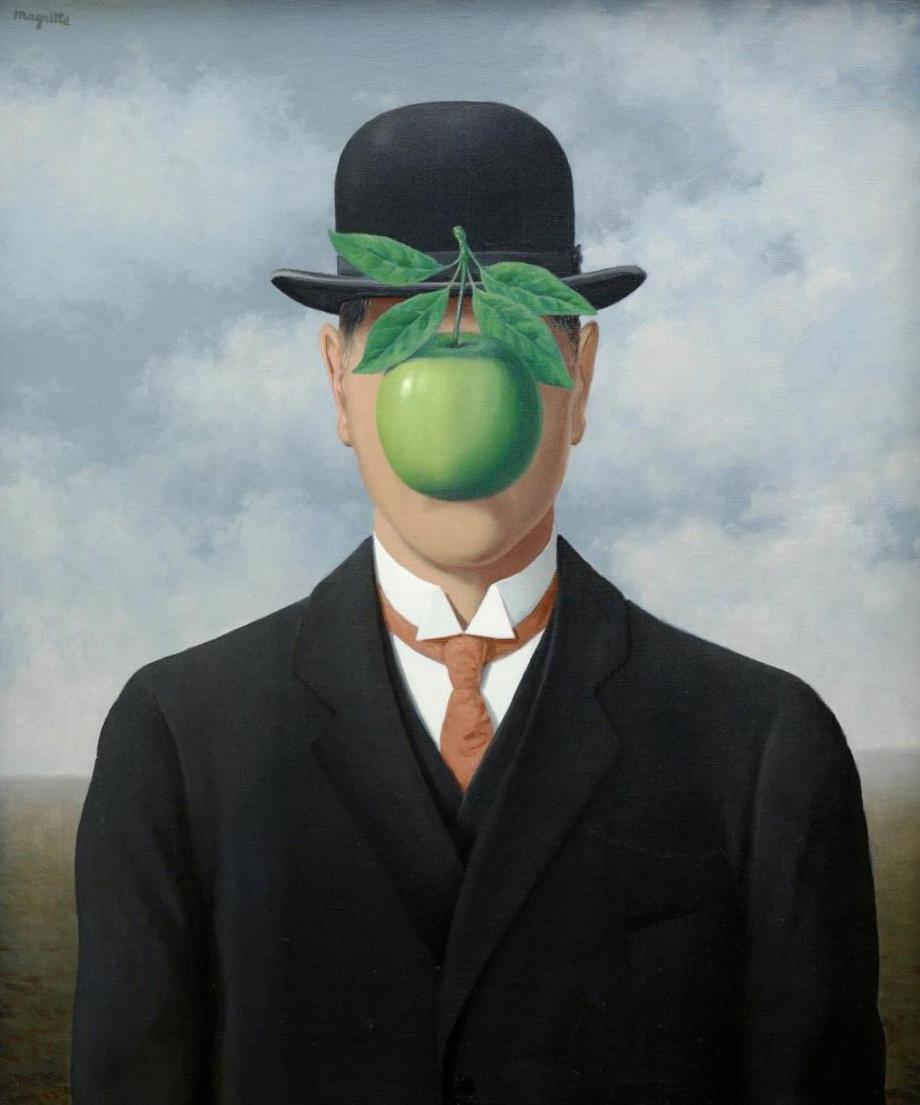
1964's " Son of Man "
Perhaps René Magritte's most well-known picture is "Son of Man." It can only be compared to "The Treachery of Images" in terms of popularity and citation frequency, which has the well-known puzzle that an image of a pipe is not actually a pipe."Son of Man" appears frequently in a variety of movies and TV shows, including the widely watched "The Simpsons," which tends to reference any and all noteworthy cultural phenomena. One of the most striking and nuanced allusions to the artwork may be seen in the 1999 film The Thomas Crown Affair, as a group of twelve men wearing coats, red ties, and bowler hats stroll around the museum while a painting is being stolen.
Two earlier pieces by Magritte, "The Man in the Bowler Hat" (1964) and "The Great War" (1964), are echoed in this picture. The hero of "The Son of Man" is shown in the first image with striking similarity to the guy, save for the fact that a white dove is soaring over his face. The backdrop of "Son of Man" is shared by the heroine of "The Great War," a well-dressed woman holding an umbrella and hiding or adorning her face with a bunch of flowers. The sky (in the first instance, blue with light clouds, in the second, covered with dismal clouds) occupies the top half of the backdrop, while the sea and a low wall or fence occupy the lower half. This artwork by Magritte is a self-portrait. It shows a guy standing next to a low wall, with smoke or clouds in the sky above and the sea below. He is wearing a coat and a bowler hat. A green apple floats in front of the man, covering virtually all of his face. The green fruit, which almost hides the man's face under the bowler hat, is thought to represent the temptations that meet Adam in the modern world.
"The interesting thing in these paintings is the presence of the open visible and the hidden visible that suddenly burst into our consciousness, which in nature is never separated from each other," stated Magritte himself of the artwork. Every visible constantly conceals another visible behind it. My paintings just unexpectedly and directly depict this condition of events. A certain dynamic occurs between what the world presents to us as visible and what this given visible conceals underneath it.
 |
| “Lovers”, 1928 |
 |
| “ Lovers ” , 1928 |
The paintings in the "Lovers" series, each with a profound philosophical message, are created in the painter's signature style employing poster technology. The first one, dubbed "Kissing Lovers," shows a lady and a man, their heads covered in distinctive folds of cloth that convey a surge of love.This allegory can be interpreted in several ways: The literal meaning of "lost their head from love." One cannot see the obvious because of the blinding intensity. A kiss through cloth represents an imaginary kind of love that cannot provide actual bliss. There is a wicked side to passion. She is covertly covered beneath white blankets because of this. The understanding of the truth does not follow from love. Not even deeply in love can make individuals totally understand one another. A more upbeat explanation would be that love is independent and unaffected by anything tangible, including a double layer of matter.
There are several plots for this painting at the moment. The most widely accepted theory attributes the author's profound early trauma—caused by his mother's death—for the production of these enigmatic visions.
A very young Magritte's mother killed herself. When the body of a stunning young lady was found, it was revealed that she had purposefully thrown herself from a bridge, and that her head had been wrapped in a piece of cloth. Maybe the woman covered her face with cloth to prevent facial disfigurement after death.
the artwork accessible in two variants. One shows a man and a woman kissing while their heads are covered in a white fabric, while the other shows them "looking" at the observer.
The sight of it astounds and captivates. Magritte illustrated the theme of love's blindness with two facesless creatures. Regarding blindness in both senses: couples are a mystery to one another and do not see anybody. We also do not see their genuine features.
We nevertheless gaze at and ponder about Magritte's lovers in spite of this apparent clarity.
Since they pose queries regarding the fundamental nature of existence, almost all of Magritte's paintings are riddles that are impossible to fully solve. Magritte frequently discusses the concealed mystery and deceitfulness of the apparent, which go unnoticed by us.
 |
| " Self-portrait " , 1923 by René Magritte |
The 1923 work "Self-portrait" by René Magritte
René Magritte enjoyed posing puzzles and preferred to stay out of the spotlight. He stayed in the shadows for decades, fooling and mystifying the people. In a number of canvases, the artist "encrypted" himself. These are the same canvases that show a mystery figure wearing a bowler hat, who over time has evolved into a sort of Magritte alter ego. At least fifty-three times in the artist's works is this man. You may even add a few dozen more to this total if you recall his "multiplied" image from the painting "Golconda." There's always intrigue around the man with the bowler hat; he might be menacing or fun at the same time.
This hero made his debut shortly after Magritte's art entered the surrealist era in the painting "Reflections of a Lonely Walker" (1926). Like in many of the paintings that followed, the figure with the bowler hat in this picture has his back to the observer. In many works, his face is partially or completely hidden—for instance, by an apple or a soaring white dove. Magritte's primary technique is to prevent the spectator from seeing him in full. The same is true of two pictures that imply autobiography: "Clairvoyance" (1936) and "Attempting the Impossible" (1928). Only one of the canvases shows the artist's profile; the other shows him at work. Furthermore, the protagonist exudes such a strong zeal for the creative process that it almost feels awkward to watch him through a keyhole.
A 1923 cubist painting is the sole piece of René Magritte's art that can legitimately be referred to be a self-portrait. But, the artist once more conceals his "real face" from the audience by covering it with a jumble of colorful planes.
 |
| " Georgette " ,1937 by René Magritte |
" Georgette " ,1937 by René Magritte
As a child, René Magritte had the good fortune to meet the love of his life. At a Charleroi fair, he ran upon Georgette Berger, the young butcher's daughter; she was two years younger than he was. For Rene, this first, innocent love turned into a genuine release.His mother, Regina Magritte, had killed herself not long earlier, and the family was going through a trying period. And having meetings with Georgette gave Rene a little reprieve from his pessimistic views. By the way, Magritte's desire to unite his life and art was sparked by an incident that occurred during one of these encounters when the young lovers witnessed the artist working outside.
Rene and Georgette had to part ways very quickly since the girl's parents chose to relocate to Brussels. After some time, in order to pursue an education in art, Magritte also relocated to the capital. And he reconnected with Georgette. Diverse accounts exist regarding their reunion: one places the pivotal encounter at an art supply store, another in a botanical park, and a third that says Rene and Georgette just happened to cross paths on the street. Whatever the case, everything was the result of coincidence. And this time, Magritte made the decisive decision to marry Georgette and hold onto his own destiny.
Georgette remained one of Magritte's most cherished muse and primary sources of inspiration for the remainder of his life. The painter has stated on several occasions that his wife serves as the model for practically every woman in his works. Furthermore, Georgette's characteristics may be seen in the majority of Magritte's female figures, even if her name is only signed in a small number of these works. Still, the majority of these were abstract representations of women that resembled his wife. In contrast, Georgette's photographs themselves start to function as type of professional checkpoints. During every phase of his career, Magritte created a minimum of one picture of his spouse, signed with her name, including cubist, surreal, and "Renoir" styles. Georgette appears to stand for a type of unwavering, significant, and unchangeable constant that follows the artist throughout his whole creative process. Still, here is the reality: Magritte shared a home with his spouse until his passing. Georgette was interred with her husband at the Schaerbeek cemetery, close to Brussels, having outlived him by over two decades.
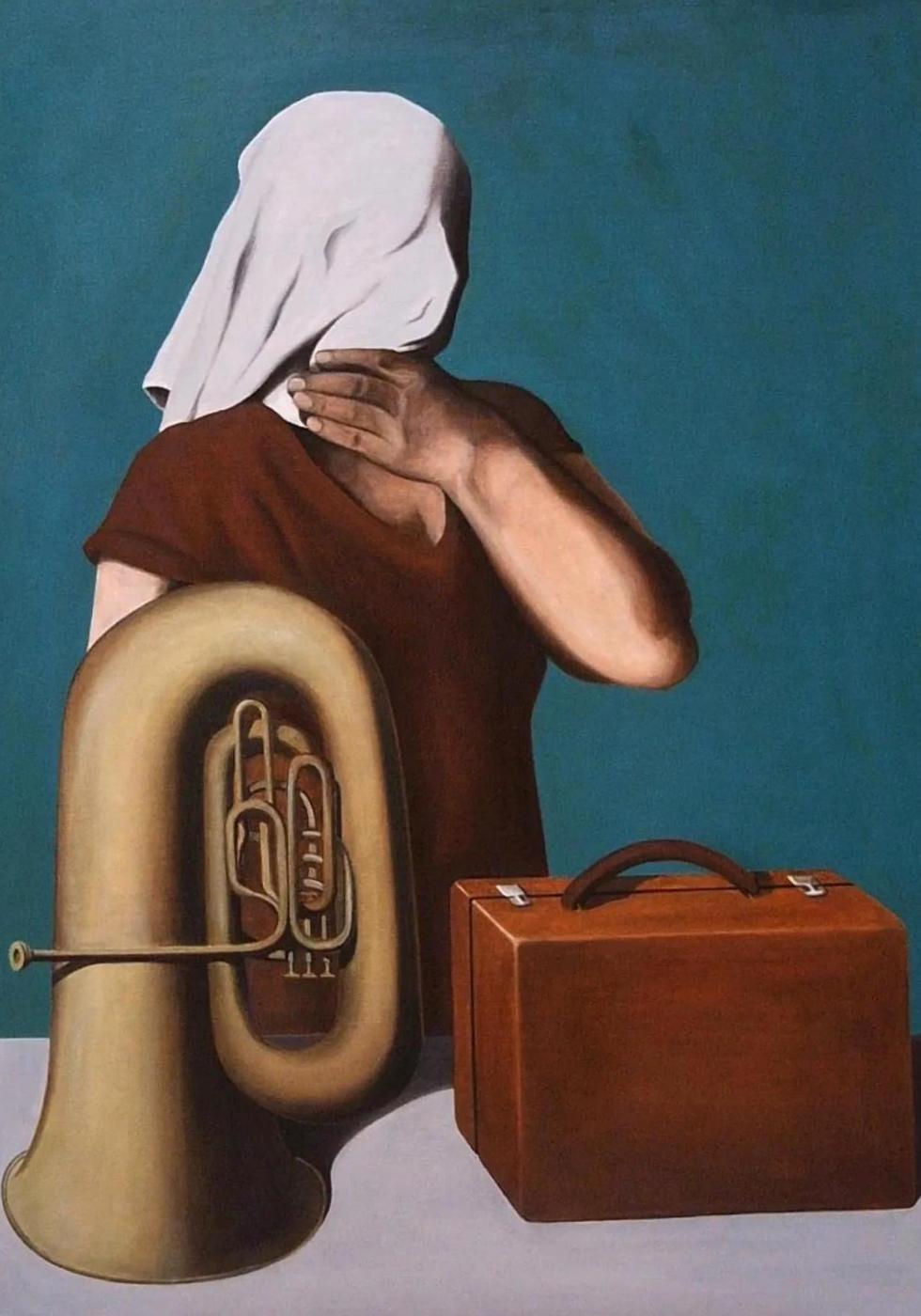 |
| “ The Heart of the Matter ” , 1928 |
“ The Heart of the Matter ” , 1928
The woman in " The Heart of the Matter " appears to be an accurate representation of the artist's mother-related recollections. Her face is concealed by the cloth, and she is squeezing her throat with her hand in an attempt to either remove the covering that is interfering or to suffocate herself.Lovers of the then-popular psychoanalysis started to "unravel" the mysteries of Magritte's paintings from the perspective of Freudian theory as the news of her death came to light. The artist flatly rejected any relationship between his personal background and the topics of his works, despite the fact that he, unlike other surrealists, was an ardent opponent of psychoanalysis. "My paintings are visible images that do not conceal anything behind them," the writer stated. My paintings arouse a sense of mystery that prompts viewers to ask themselves, "What does this mean?" However, this is meaningless since the mystery is also meaningless because it cannot be known.
_res_res.JPG) |
| “Man in a Bowler Hat” - Rene Magritte |
“ Man in a Bowler Hat ” - Rene Magritte
In some of his pieces, Magritte included the image of a guy wearing a bowler hat. Many attempts are currently being made to decipher the painting's symbolic subtext, which critics of art sometimes refer to as an intellectual provocation. René Magritte gave this explanation of his concept: "Mr. Mediocrity with all his obscurity is a guy wearing a bowler hat. In addition, I don a bowler hat because I don't really want to stick out from the crowd.
The man's face is obscured in the painting, giving the impression that a dove suddenly landed in the frame right before Magritte "clicked" to finish it. From the human, the bird flies from left to right in the direction of the light. The left eye of a bird is visible, but not the eyes of a human. Furthermore, the man's tie has a pale pink color as opposed to the vivid red tie that The Son of Man (1964) features.
What drew Magritte in and set him apart from most other surrealists was the feeling of mystery and miraculous. He followed his canon of frozen visuals and flat measures to the letter. His greatest works were more about enticing the audience to perceive life beyond of the concrete and the present than they were about challenging the viewer.
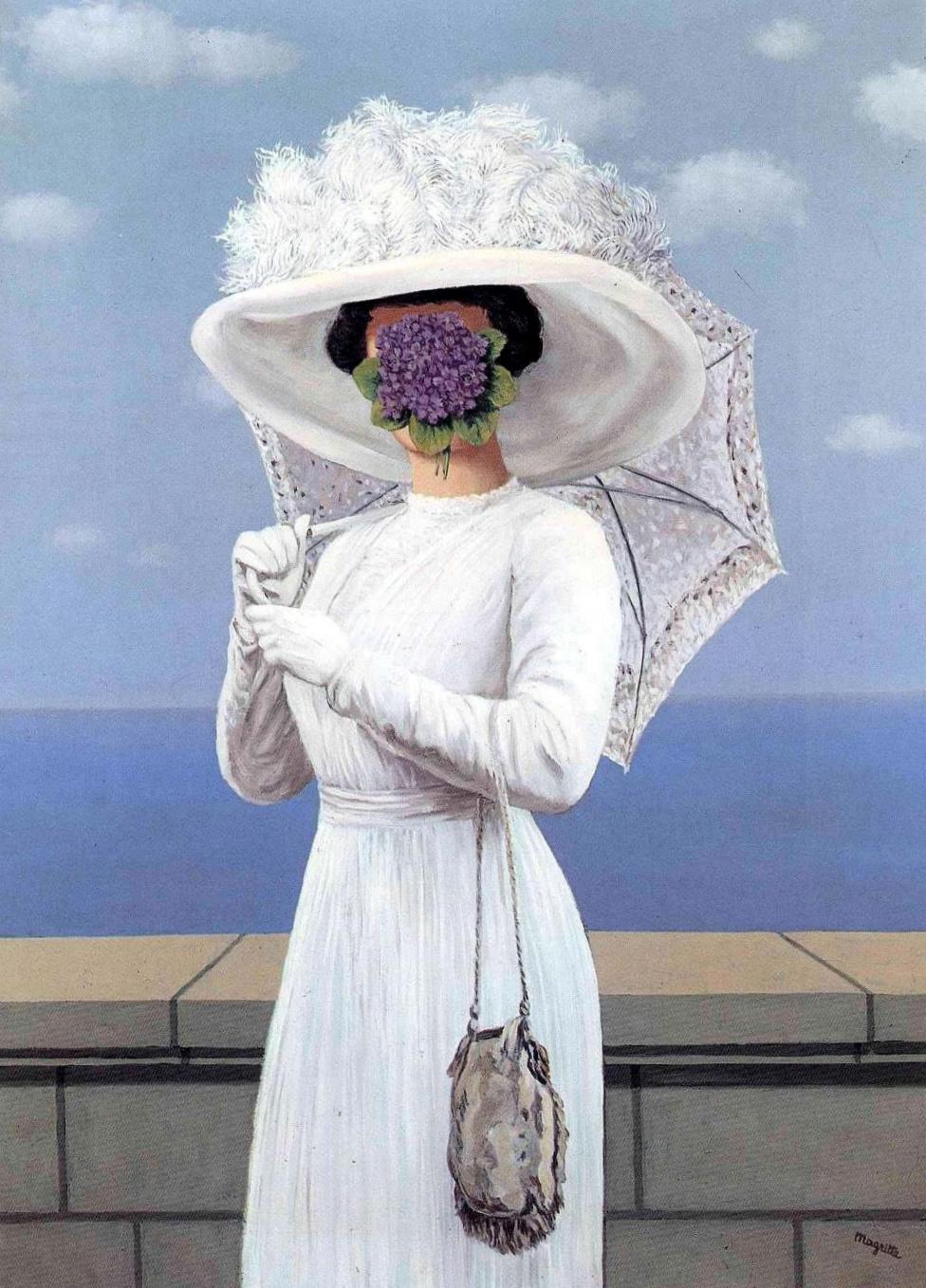 |
| " The Great War " , 1964 |
" The Great War " , 1964
awareness this work also requires an awareness of the woman's attire, as when a soldier died in combat while betrothed to a female, the girl remained an eternal bride and a widow dressed in white. This effect is strengthened with a bouquet of violets, which are a sign of compassion and purity similar to a bride's bouquet. This bouquet, which conceals the face, appears to shield sadness and despair from prying eyes, leaving only a poignant reminder of the things that war may take away. The only information we have about this woman and the man she was promised is what happened to them.
The word "viollette," which means "violence" in French, alludes to bloodshed, namely war, and seems to have been the reason behind the lovers' eternal separation. Three years before to his passing, Magritte, an elderly man who had previously experienced the horrors of two world wars, produced this piece. It's possible that the artist used a metaphor to convey his sorrow about these occurrences by showing a bride alone on a pier that runs across a desolate sea, wearing a white wedding dress and an already pointless bouquet.
The interpretations of the artwork featuring a woman are as varied, despite it being less well-known than the linked piece "Son of Man". The term "Great War" clearly alludes to the violent events of the 20th century. The artist appears to be hinting that the face of war can be far more monstrous than its robe, woven from promises and deceitful hopes, and that war is an impersonal violence that destroys human destinies and the normal way of life. This is evident from the way the artist has hidden the woman's face behind a gorgeous bouquet.
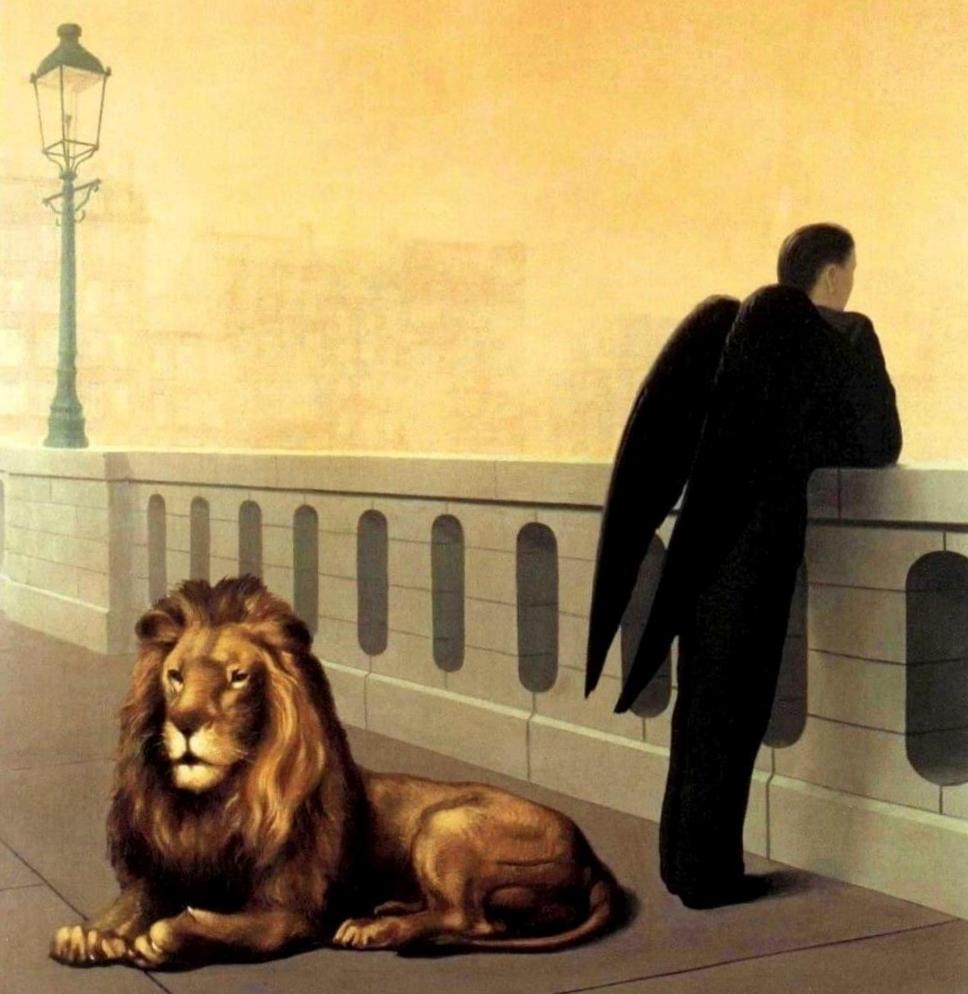 |
| “ Homesickness ” , 1940 by Rene Magritte |
“ Homesickness ” , 1940 by Rene Magritte
Unquestionably, "Homesickness" is among Rene Magritte's most personal and emotionally honest pieces. You can even tell by the title: the artist titles the canvas honestly and succinctly, reflecting his emotions while painting, as opposed to selecting something conventionally fanciful and bizarre. During World War II, in 1940, the Nazis took control of Belgium, forcing Magritte to escape the nation. It's natural to suppose that the artist discusses his experiences of living in virtual exile in "Homesickness." Nonetheless, a few art historians think that the title and the artwork have a deeper significance. In this instance, being homesick also refers to not being able to go back to childhood, which is the most carefree and peaceful time of life. That being said, Rene Magritte's actual upbringing was only somewhat like this. The boy's mother committed herself when he was just 13 years old, and the family traveled around a lot.
For a youngster on the verge of puberty, this was not an easy exam. When Rene's father died in 1928, Magritte's wife Georgette was the only person who knew him well. The couple was homesick and lived in the Paris suburbs at the time.
They eventually made their way back to Brussels, where Magritte quickly achieved his first degree of notoriety.René Magritte traveled to London in the latter part of the 1930s, and it was there that he suddenly fell in love with Sheila Legg, a young surrealist artist and model. The artist requested his buddy Paul Colinet to spend more time with Georgette so as not to offend her and cause needless distrust in her. An affair was the inevitable result of this, and at one point Georgette even proposed that Magritte obtain a divorce.
As a result, the artist found himself separated from both his girlfriend and his home in 1940 when she declined to accompany him. Magritte spent three months living with poets Paul Eluard and Louis Scutener in Carcassonne, France. Then he created "Homesickness," where he supposedly portrayed himself as a lone angel on a bridge, according to art critics. What dark thoughts must have raced through a man's mind when he was literally "thrown from heaven to earth," abandoned and without a place to call home or his own soul. According to some experts, Georgette is symbolized by the lion in this image, who is facing the angel and appears apathetic. The composition as a whole is said to depict the strained relationship between the couples at that period.
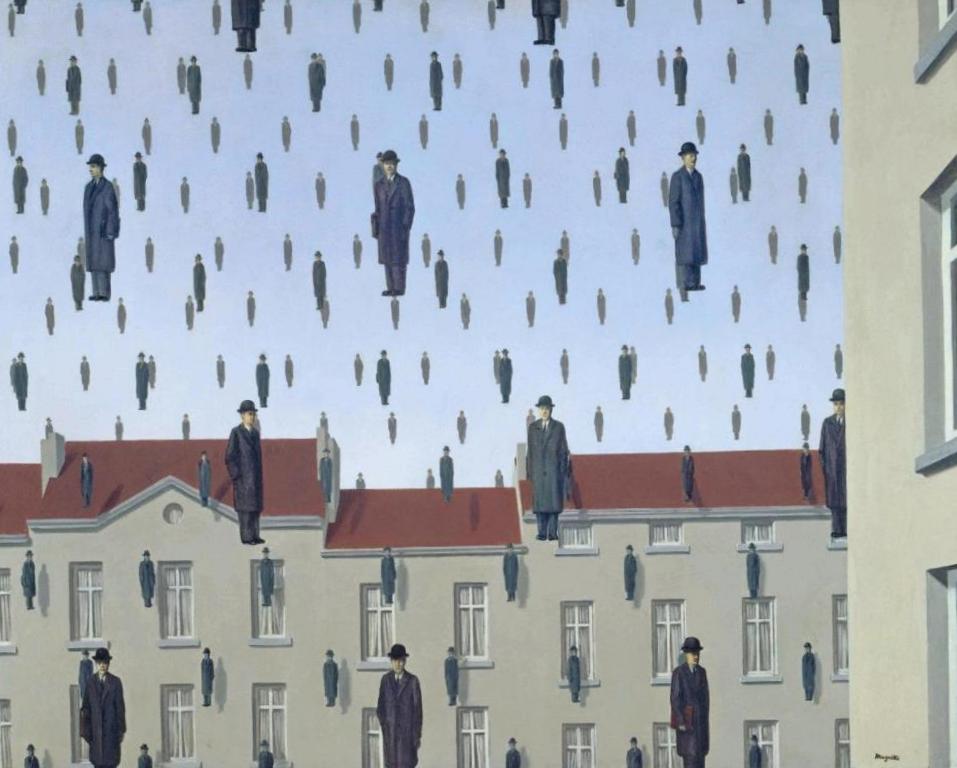 |
| “ Golconda ” , 1953 by René Magritte |
“ Golconda ” , 1953 by René Magritte
The canvas was named after the ancient Indian city, famous for the mining of especially large diamonds (according to legend, it was here that the famous Kohinoor and Regent stones were found). As with most of Magritte's paintings, the title of the painting is a kind of rebus that forces the viewer to stop and think about how exactly it relates to the image.But art historians believe that the arrangement of men in bowler hats on the canvas resembles the crystalline structure of a diamond. If you don’t dive so deeply and remember that the surrealists often gave their paintings titles that were completely unrelated to the plots, we can assume that “Golconda” depicts a rain of men in bowler hats. And if at first they seem like a solid faceless wall, then if you look closely, you will notice that each of the heroes of the canvas is very slightly different from the others. Just like there are no two completely identical raindrops or two completely identical gems.
“Golconda” is the artist’s reflection on the place of man in society.
The figures are arranged in the form of rhombic lattices, which are reminiscent of the crystalline structure of diamond.
Society, which is initially perceived as a chaotic mass, actually has a structure and operates within fairly rigid boundaries.
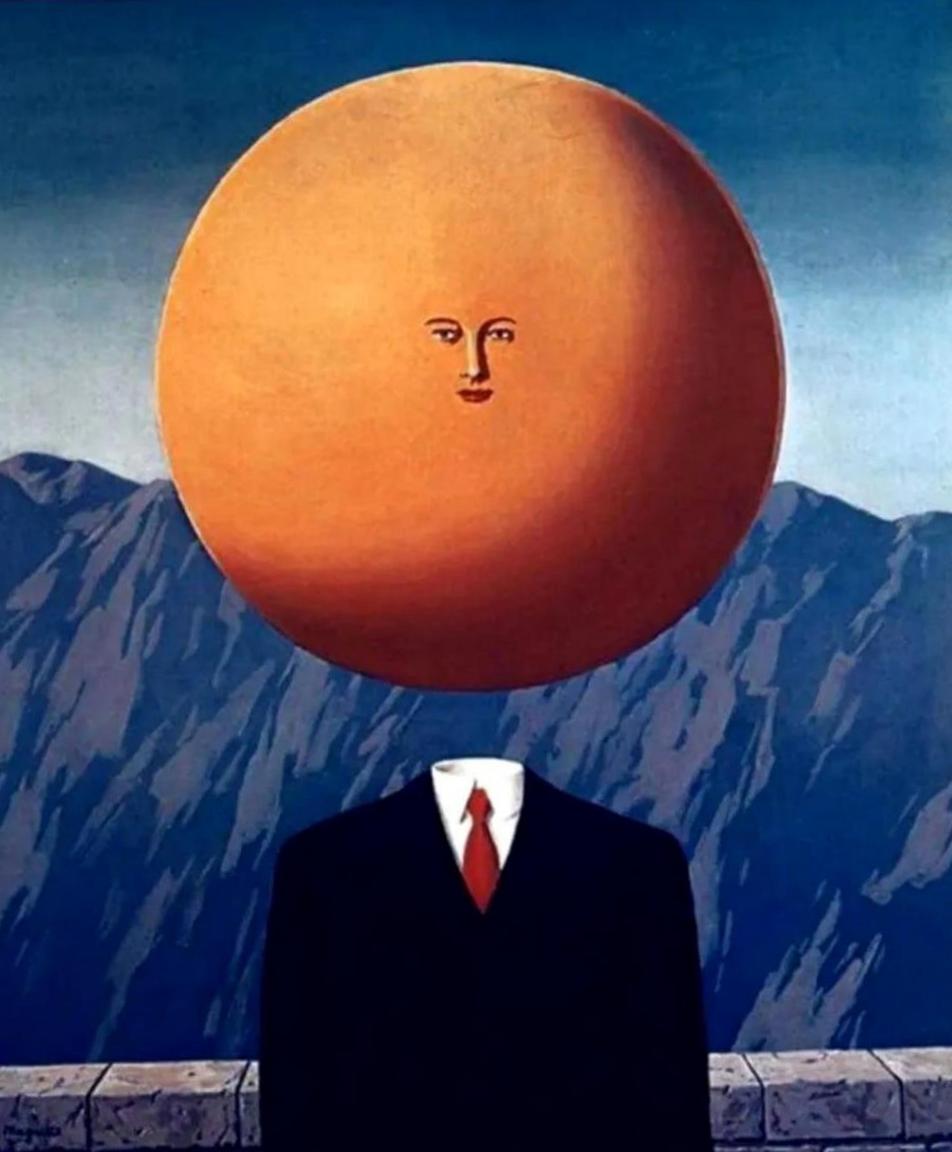 |
| " The Art of Living " , 1967 |
" The Art of Living " , 1967
Magritte painted "The Art of Living" in 1967, not long before he passed away. The original recipient of the piece was New York art dealer Alexander Iolas. at 1948, Magritte started working with him, and with the signing of a contract with Iolas, he was able to display his work at galleries located in New York, Paris, and Geneva, leading to his international recognition.
There are two sets of oppositions in "The Art of Living" artwork. The figure in the middle of the painting is separated into two parts: his body is part of the iconic figure created by Magritte, the man in the bowler hat, whose identity is made clear by his consistent use of a formal suit and red tie.However, the head appeared to be from an entirely other opera as it hovered over the body. With her disproportionately large size, boldly brilliant hue, and disproportionately tiny face features, she resembles a children's book sun or a weird planet.
This contentious persona has a similarly contradictory past. The majority of it is covered in rocky mountains that reach nearly the horizon, yet massive masonry keeps them apart from the picture's hero. What may these pictures represent? The term emphasizes that the art of life is in striking a balance between letting things happen naturally and depending on one's own efforts, like the difference between a man-made wall and a natural landscape.
Regarding the weird guy, it is possible to think of him as a rebus that conceals Magritte's own way of existence. As an artist, the artist always followed a very traditional lifestyle, on the one hand. He had just one wife during his whole life, spent a lot of time painting artwork in the kitchen, and somehow avoided ever getting paint on the floor. This facet of the artist's personality is not related to any specific controversies or issues; rather, it is the result of the stiff suit in the painting.
However, his art does not fit this picture of a model citizen; rather, it is satirical, occasionally controversial, and unrestricted in its imaginative flight. It is only because of this freedom that an unsightly, enormous orange head may be attached to a respectable-looking body in every way; this is by no means the most bizarre arrangement of bodily parts that the Belgian surrealist permitted.
Even yet, Magritte disapproved of any interpretations of his art. "The visible images in my painting are empty of any inherent meaning."
 |
| “ Collective Invention ” , 1934 |
“ Collective Invention ” , 1934
1934's "Collective Invention"
The term "Collective Invention" has several meanings that can be interpreted in different ways. Among other perspectives, the picture is understood from the standpoint of:
1. feminist critique, which highlights the surrealists' dehumanization and objectification of the female form and points out that the only possible purpose for the creature portrayed on the canvas may have been sexual;
2. Christian symbolism, which views water as the embodiment of baptism and atonement for sins and fish as a representation of the first Christians. The idea of the sexualized, lifeless anti-mermaid is nearly blasphemous in this interpretation and goes against morality;
3. psychoanalysis and Freudian themes - taking into account Magritte's propensity to depict heroes near water and individuals with their faces covered from the observer as a result of trauma experienced as a youngster. The artist's mother killed herself, and the lore has it that her face was covered in a nightgown when she was recovered dead from the river.
However, it is important to keep in mind that Magritte himself was always focused on the fact that his works have no particular semantic burden when attempting to convey the concept hidden in the piece.
 |
| " Harvest Month ", 1959 by Rene Magritte |
" Harvest Month ", 1959 by Rene Magritte
The artwork "Le mois des vendanges" sold for $10,002,500 at Christie's auction on March 3, 2021. This is a really astounding number, yet it is not the greatest price for paintings by the Belgian surrealist. By the way, Magritte thought highly of this composition. "Harvest Month" is now the finest reminder of how odd life may be if a person has a "sense of reality," yet my other paintings may also be pretty intriguing or even endearing. - Magritte René.
One of the most iconic images from Magritte's creative world, the "man in a bowler hat," is presented in its largest form during "Harvest Month." , There are so many "kettles" in this piece of art that the artist has never used before—and they all have faces that are seen and unmasked by extraneous items!
The painting gives the visitor a depressing existentialist impression of a dark, empty room with a plain gray window. We are sick of boring interiors and desire to see daylight and a gentle scenery behind the window, but alas! All the beauty our imagination has worked up to this point is entirely obscured by an infinite fleet of very identical men in bowler hats. There is a clear and strong sense that the viewer's curious glance is being rebuffed, deflected, and maybe even called into question as to whether or not he is even capable of seeing the similarly focused, quite robotic look of the several "kettles" gathering outdoors. Currently, "The Harvest Month" is one of Magritte's four major works that are still in private ownership. The artwork was purchased in Paris in the 1960s by renowned collector Claude Erzen, who went on to amass one of the greatest collections of surrealist paintings worldwide.
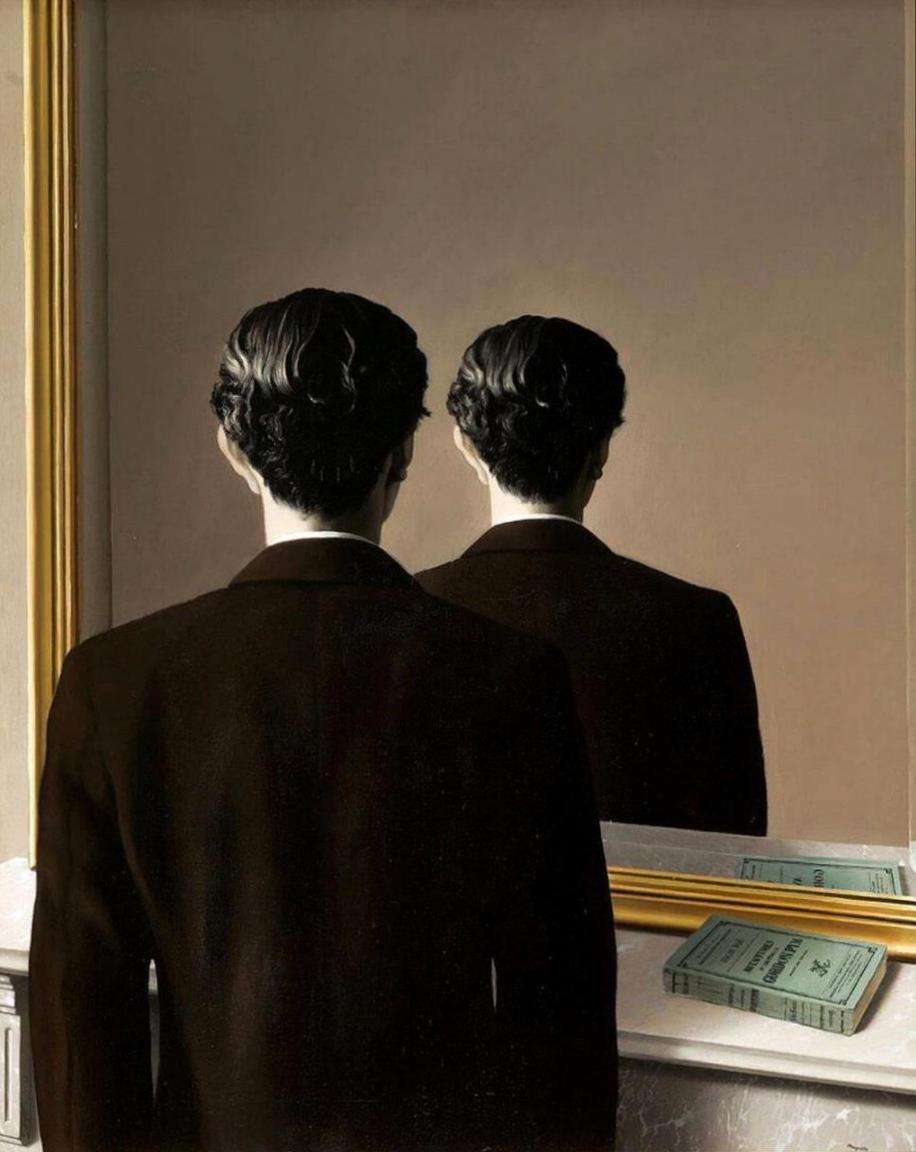 |
| " Reproduction prohibited " |
The book "The Narrative of Arthur Gordon Pym" by Poe is the subject of this artwork by Magritte; it is a tribute to both ignorance of one's own actual nature and the idealistic philosophy espoused by Poe. In this enigmatic novel, emergency marine conditions push Arthur Pym to cope with an unknown himself. The distance one might feel from oneself, which makes it harder to emancipate to the work—as this picture appears to suggest—without seeing the "face in the mirror" and just reflecting half of the book, illustrates how troublesome it is to perceive art exclusively via one's senses. Imagine also going through the same range of feelings during the protracted process of creating a masterpiece that portrays anguish, from the initial draft to the last details. One of the most significant authors of the 20th century, Fernando Pessoa, was a Portuguese poet and writer who famously stated, "The poet is a fake \ Who is so good at his work \ He even feigns pain \ From the pain he really feels."
 |
| " Teacher ," 1952 |
" Teacher ," 1952
The fact that this is probably a generic representation of the typical citizen may be one of the reasons it is unnecessary to reveal his face—anyone may take his place.The title "Teacher" in the picture is an example in point. It has little bearing on the story and could have just as easily been named "Engineer" or "Musician"; not much would have changed. In the middle of a desert, someone would remain standing in the light of the new moon.
It frequently took Magritte a great deal of effort and investigation, even if the names of his works actually baffled him greatly. He was anxious to make sure they did not provide simple answers for interpretation. For instance, he once declined to paint a picture of mountains with the title "Curtain Cords" because he thought it would be associated with climbing safety ropes. "Paintings are not illustrations of titles, and titles of paintings are not explanations," the artist said. "The title and image have a poetic connection, meaning that it only highlights certain aspects of the subject that we typically aren't aware of but occasionally pick up on instinctively when strange things happen that defy logic."
 |
| " The Castle in the Pyrenees " |
" The Castle in the Pyrenees "
Harry Torchiner, the artist's lifelong friend and a renowned worldwide lawyer, poet, and writer, commissioned the masterpiece "The Castle in the Pyrenees" by Belgian surrealist René Magritte. The correspondence between the two men chronicles the painting's history and evolution. Despite Magritte's total autonomy, the communication reveals that his patron was asked for his input on the topic choice. Torchiner selected one of the enormous stones with a castle above it from among several ideas that Magritte had presented. Torchiner, who was well acquainted with the artist's past work, added the image of a stormy, black sea and a blue sky, with the saying "because above the dark sea or ocean rises a rock of hope, crowned with a fortress, a castle." As the work developed, Magritte made the decision to leave out further elements that had been suggested in order to preserve the "strength" and "sharpness" he had in mind. Today, "Castle in the Pyrenees" stands as one of Magritte's most widely recognized and copied pictures. It exemplifies the artist's usual unnerving combination of mysterious elements and engrossing poetry with everyday items.
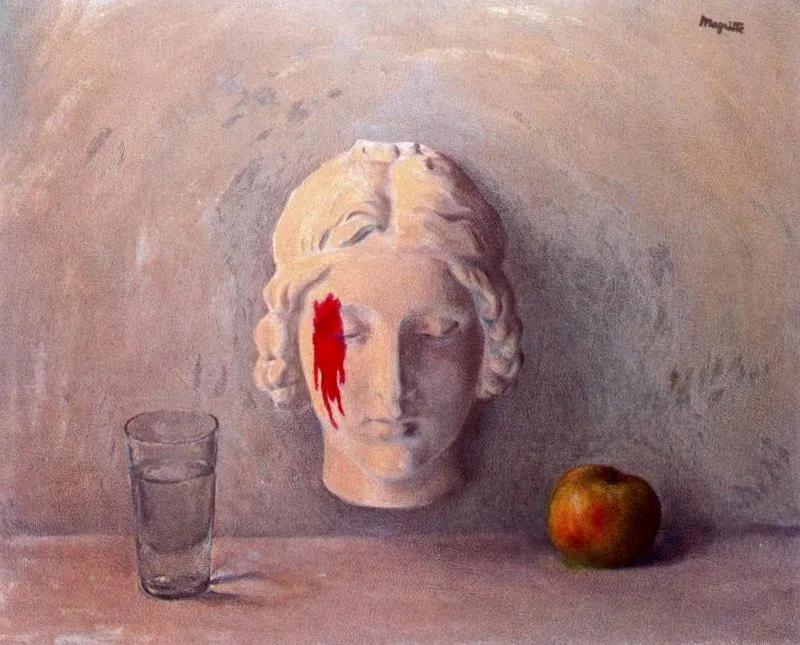 |
| " Memory " , 1948 |
 |
| " Memory " |
" Memory " , 1948
The painting captures the essence of Hegel's philosophy, showing us that life is magical because we are always faced with seemingly endless choices between two enormous schools of thought. Even though we never reach the solution, the process itself never ends, leaving behind "markers" of mental anguish. "You will no longer see the thing itself, but concentrate on your question, if you look at a thing with the intention of trying to understand what it means," declared artist René Magritte.
_res.JPG) |
| " This is not a pipe " |
" This is not a pipe "
"Lies come in a wide variety. René Magritte possesses a well-known artwork. Photographically accurate, it shows a smoking pipe with the words "This is not a pipe" printed underneath. As you gaze upon this artwork, you wonder how it's possible. Give yourself a few minutes, though, and you'll realize what it is—that a lie may be really subtle. Magritte's picture simply conveys the idea that a pipe is only an image. So thin that the nasty quality virtually disappears."
Gerard Richard.
"The well-known pipe. How I was chastised by people over this! But might it be a pipe, still? No, it's simply her idea, isn't that right? I would be dishonest if I stated, "This is a pipe," therefore.
Magritte René
 |
| “ Hegel’s Vacation ” |
“ Hegel’s Vacation ”
"I quickly realized that this object (umbrella) could be of great interest to Hegel (he is also a genius), because my object combines two opposing aspirations: it does not want water (pushes her away) and wants water (picks her up)" is how Magritte described his artwork.
 |
| " Memory " |
 |
| " The Pleasure Principle " by René Magritte |
" The Pleasure Principle " by René Magritte
Edward James, an aristocrat, billionaire, and significant surrealist benefactor, is shown in this picture. By the way, Rene was introduced to him by Salvador Dali. "The Pleasure Principle" is a contradiction about portraits: in a dark room, we require light to see someone's face; here, however, the light hides and obscures.
In one of the rare interviews, Magritte stated, "Everything visible hides something; we always want to see what is hidden behind what we see." Despite this, he disliked conversations about the meanings underlying his works. This curiosity may manifest as a struggle between the obvious and the obvious-hidden, or as a rather contradicting emotion. In Magritte's
 |
| Endless Gratitude |
.JPG) |
| " Philosopher's Lamp " , 1936 |
.JPG) |
| " Reclining nude " , 1928 |
.JPG) |
| The Prepared Bouquet, 1957 |
.JPG) |
| The Survivor, 1950 |
.JPG) |
| The Taste of Tears |
.JPG) |
| Depths of Pleasure, 1947 |
.JPG) |
| The spot on the map, 1955 |
.JPG) |
| The World of Images, 1950 |
.JPG) |
| Wonderland was painted, 1964 |
.JPG) |
| Masterpiece, or the secrets of the horizon, 1955 |
.JPG) |
| The Art of Conversation, 1950 |
.JPG) |
| The happy donor |
.JPG) |
| The Improvement, 1962 |
.JPG) |
| The Great Family |
.JPG) |
| Variation of Sorrow, 1957 |
.JPG) |
| Overall, 1964 |
.JPG) |
| The meeting |
.JPG) |
| Insight, 1936 |
.JPG) |
| Self-Portrait |
.JPG) |
| Pandora's box, 1951 |
.JPG) |
| The Meaning of Night, 1927 |
.JPG) |
| High Society |
.JPG) |
| The Face of a Genius, 1926 |
.JPG) |
| Wrath of the Gods, 1960 |
.JPG)
René Magritte war ein bekannter surrealistischer Maler des 20. Jahrhunderts aus Belgien. Er ist dafür bekannt, humorvolle Gemälde zu schaffen, die auch lyrisch rätselhaft sind. Magritte ist unter den Surrealisten insofern einzigartig, als er gewöhnliche, aus seltsamen Verhältnissen abgeleitete Materialien verwendet und diese anstelle außergewöhnlicher Materialien anwendet. Seine Bilder regen zum Nachdenken an und ähneln manchmal Rätseln. Diese Rätsel sind jedoch unlösbar, da sie grundlegende Fragen der Existenz selbst berühren. René Magritte, der als einer der größten Surrealisten aller Zeiten gilt, bezeichnete seinen Malstil als „magischen Realismus“. Im französischsprachigen Teil Belgiens wurde René François Ghislain Magritte 1898 in eine Familie von Hutmachern und Kaufleuten hineingeboren. Aufgrund seiner ruhelosen Natur zog Magrittes Familie häufig in die Stadt um. Danach spielte Magritte häufig auf seine Abneigung gegen das Reisen und die daraus resultierenden Veränderungen an.
Mit vierzehn Jahren erlebte der Jugendliche ein traumatisches Ereignis, das seinen Geist tiefgreifend beeinträchtigte: Seine deprimierte Mutter beging Selbstmord, indem sie im Fluss Sambre ertrank. In seiner Biografie besprach René Magritte dieses schreckliche Ereignis und äußerte Zweifel an der Richtigkeit seiner Erinnerung daran, wie er das von einem weißen Nachthemd bedeckte Gesicht der Mutter gesehen hatte, als sie aus dem Wasser geholt wurde, und darüber, ob René Magritte sich das eingebildet hatte oder nicht besonderes Detail. Dennoch zeigen einige Werke des Künstlers Situationen, die zu ertrinken scheinen („Collective Invention“) oder von Stoff verdeckte Gesichter zeigen („Lovers“, „The Invention of Life“, „The Heart of the Matter“). Der junge Mann zog 1916 nach Brüssel, um sich an der Royal Academy of Arts einzuschreiben. Während des Ersten Weltkriegs wurden zahlreiche Institutionen eingestellt und die Akademie nahm eine zentrale Rolle im Studentenleben ein. Magritte hatte eine enge Beziehung zu Literaturstudenten und kommunizierte immer lieber mit ihnen. René Magritte heiratete Georgette Berger 1922 nach seiner Entlassung aus der Armee, nachdem er sie im Alter von fünfzehn Jahren zum ersten Mal gesehen hatte. Renes Frau wurde zu seinem wichtigsten Vorbild und er entschied sich sogar dafür, in der Küche statt im Studio zu arbeiten, um in ihrer Nähe zu sein. Neben dem Malen von Covern für Notenblätter, Filmplakate und Werbung arbeitete der junge Künstler nebenbei als Designer in einer Tapetenfabrik, um seine Familie zu ernähren. Magritte entwickelte schnell ein Interesse an der Arbeit des italienischen Malers Giorgio de Chirico, der Pionier des anachronistischen Stils war, indem er scheinbar widersprüchliche Elemente der Realität gewagt kombinierte. Er nutzte mehrere der kreativen Mittel von de Chirico, darunter Doppelbilder, Collagen und die Gegenüberstellung erkennbarer Gegenstände. Die endgültige Form von Magrittes Stil entstand Ende der 1920er Jahre.
_res_res.JPG)





_res_res.JPG)











_res.JPG)




.JPG)
.JPG)
.JPG)
.JPG)
.JPG)
.JPG)
.JPG)
.JPG)
.JPG)
.JPG)
.JPG)
.JPG)
.JPG)
.JPG)
.JPG)
.JPG)
.JPG)
.JPG)
.JPG)
.JPG)
.JPG)
.JPG)
.JPG)
.JPG)


.JPG)
.JPG)
.JPG)
.JPG)
.JPG)



No comments:
Post a Comment